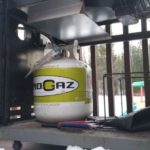Choose The Right Tent For You
Choosing a new tent can be a lot of fun. You get to pick your mini getaway home and can look for as many accessories and add ons as you like. There are the obvious considerations like the amount of space you will need and the colors you like.
But then there are the things that often go unnoticed until you’ve used your tent on a few camping trips and realize that it may not be as durable as you expected. Maybe it doesn’t hold up in the wind too well or the rain seeps through the floor and soaks your sleeping bag.
We’ve compiled a list of the tent construction components and the products that they’re made of. Before purchasing a new tent, be confident that the one you choose will hold up in the situations you expect to camp in.

Tent Poles
There aren’t many parts to making a tent, but no part is more important in keeping your tent from collapsing than the tent poles. Tent poles form the frame of your tent and provide the support needed to hold the inner tent up in place.
Tent poles are generally made from one of four materials; aluminum, fiberglass, carbon fiber or steel. Each material serves its own purpose and the need for one over another will depend on your personal preference and needs.
Aluminum Tent Poles
Aluminum tent poles are some of the most commonly used in the construction of tents. The reason behind their high usage is that aluminum is fairly lightweight, beating out its fiberglass and steel pole counterparts.
Additionally, aluminum is flexible enough to bend to the shape required for the structure and if overloaded by snow or high winds, will typically bend rather than break. This allows for much easier repairs when needed.
While aluminum tent poles won’t rust like steel tent poles, they can still be affected by corrosion caused by environmental elements. Corrosion will cause a weakening of the poles and reduce the lifetime for them. Proper care and storage will be required to keep aluminum tent poles in good, working order.
Fiberglass Tent Poles
While aluminum might still be the most prevalent, fiberglass tent poles would likely come in a close second. They have gained popularity as a cheaper alternative to aluminum while still maintaining enough flexibility to form the structure of a tent. Another major bonus to fiberglass tent poles is that they are both rust and corrosion resistant. This makes maintenance of them a breeze.
However, fiberglass tent poles are heavier than aluminum and are often made with a larger diameter in order to match the strength needed. They also aren’t able to bend nearly as much as aluminum and will break if overloaded. Once broken, they will need to be replaced as repairs are usually not possible.
Carbon Fiber Tent Poles
Carbon fiber tent poles provide a mix of pros and cons from aluminum and fiberglass tent poles. They are ultra lightweight which makes them excellent for packing and carrying. This is typically the main factor when deciding on carbon fiber. They also provide a sufficient amount of flexibility and won’t rust or corrode.
A few downfalls to carbon fiber tent poles still do exist. They are more expensive than the other alternatives. Furthermore, they are more susceptible to crushing or breaking and like fiberglass, will require replacement rather than repairs.
Finally, because carbon fiber tent poles are made from small fibers wrapped in a specific coating, the ends can become damaged and fray with repeated wear and tear. This makes careful handling and maintenance even more important.
Steel Tent Poles
While steel tent poles may be the least popular of the four, they do have their place among the camping realm as well. They are usually required for large structures that need a lot of support.
While steel may be the strongest meaning that it won’t bend or break easily, it does come with additional weight and reduced flexibility.
Steel is also susceptible to rusting which means that proper cleaning and removal of moisture is required for storage.

Tent Fabric – Inner Tent and Rainfly
The inner section of the tent consists of the walls and ceiling while the rainfly makes up the roof that covers the ceiling. In some cases the rainfly will cover the walls as well for added protection. Typically, both of these parts will be made from one or a combination of durable fabrics like nylon, polyester or canvas. The typical camper will be looking for something that is waterproof and that won’t tear easily. Each person will have to select the materials that best suit their camping situation.
Nylon Tent Fabric
Nylon is a popular tent fabric due to its strength and durability while also being lightweight. The material is fairly stretchable which is a positive for ease of setup and adds to its durability. It is also easy to wipe clean and doesn’t stain.
While nylon is water resistant, it is not waterproof. In order to make nylon tent fabrics waterproof, a coating of acrylic, polyurethane, or silicone is applied. The coating will last a long time but eventually will begin to break down which in turn causes weak spots in the tent where water may leak.
Nylon tent fabric is not breathable. It does not allow air flow through the fabric, meaning that it is more susceptible to condensation forming without proper air vents in the tent.
Polyester Tent Fabric
Polyester tent fabric is the most popular among typical car camping, local campground tent campers. The materials durability is similar to nylon and also provides for good stretchability. The main difference between nylon and polyester tent fabric is in the weight category. Polyester is heavier than nylon which makes it more ideal if you are not carrying it long distances.
Like nylon, polyester tent fabric is water resistant and therefore requires a coating in order to make the tent waterproof. One added bonus to polyester is that it is less prone to fading from sun exposure.
Polyester is famous for being a breathable material. It’s part of the reason why it is so popular for workout clothes. Those same properties make it perfect for tents to reduce condensation and regulate temperatures.
Canvas Tent Fabric
If you are a winter camper or if you’re planning to camp for extended periods of time, then a canvas tent fabric might be the right choice for you.
Canvas or cotton is extremely durable and sturdy. It is also easily repaired if it does become damaged. It has excellent waterproof properties in addition to its insulating value. Canvas tent fabrics reduce the formation of condensation while remaining warm in the winter and cool in the summer. Additionally, it can safely be equipped with a stove for winter camping.
The downfall for canvas is that it is heavier and bulkier than its counterparts, making it unsuitable for your average backpacking trips. It is also the most costly of the three tent fabrics.

Tent Anchors
Tent anchors are used to secure the guy lines to the ground making them an integral piece in the strength of your tent setup. Oftentimes the provided anchors will not be suitable for your needs as they may be prone to bending or breaking. When selecting tent anchors, look for a durable material like metal and make sure that the size of the anchor will suit your needs. Avoid plastic unless you will be in very soft ground as plastic will easily break.
If you are planning to winter camp, consider getting some anchors that screws into the ground as they will turn into the frozen ground more easily than pounding with a hammer.
As you can see, the decision to buying a tent goes beyond how much space you need. In order to ensure that you are getting the quality and durability that you need, look at the materials that are used to construct the tent and find the one that best suits your needs.




